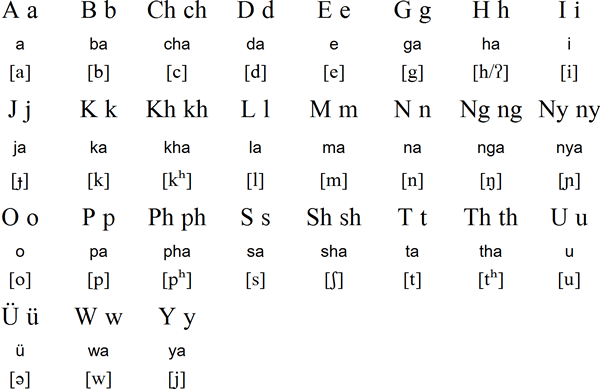Chang is a member of the Brahmaputran branch of the Sino-Tibetan language family. It is spoken in 36 villages in the Tuensang District in east-central Nagaland in the northeast of India. According to the 2001 Indian census, there are 62,000 speakers of Chang.
The language is also known as Chang Naga, Changyanguh, Machongrr, Mochumi or Mojung. The Tuensang village dialect is reported to be intelligible to all Chang speakers.

H is pronunced [h] at the beginning of syllable, [ʔ] at the end of syllable.
Download a Chang alphabet chart (Excel)
Khuthüka kibü Abou, Ka nyen saopobü yingshi, Kaibü Sangle kaiya, Khuthüka kibü tegü, kaodakakei kamaang leshi. Kün la tat chaangbou shausiyung kubü; Künei ailai müeibü shedbü apbuan ki kho tegü küneibü shedbükei apbuma. Hobaje kün takteibü to teleima, lausikei amaibou ka kün senetashi.
Source: https://www.bible.com/en-GB/bible/961/MAT.6.NAGC
Information provided by Michael Peter Füstumum
Information about Chang | Numbers | Tower of Babel
Information about Achang
https://en.wikipedia.org/wiki/Chang_language
http://www.ethnologue.com/18/language/nbc/
http://wals.info/languoid/lect/wals_code_chg
http://www.language-archives.org/language/nbc
Atong, Chang, Garo, Kokborok, Phom, Tangsa, Wancho
Languages written with the Latin alphabet
Page last modified: 23.11.23
[top]
You can support this site by Buying Me A Coffee, and if you like what you see on this page, you can use the buttons below to share it with people you know.

If you like this site and find it useful, you can support it by making a donation via PayPal or Patreon, or by contributing in other ways. Omniglot is how I make my living.
Note: all links on this site to Amazon.com, Amazon.co.uk
and Amazon.fr
are affiliate links. This means I earn a commission if you click on any of them and buy something. So by clicking on these links you can help to support this site.
[top]